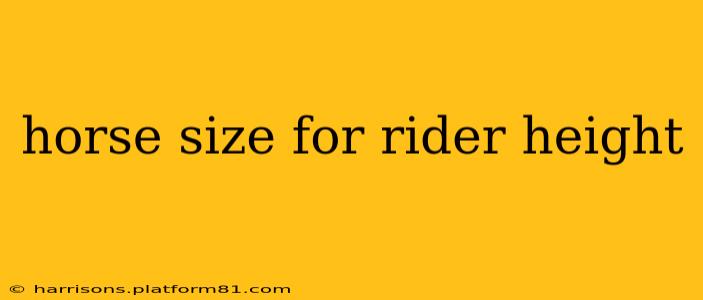Choosing the right horse size for your height is crucial for both your safety and comfort, as well as the horse's well-being. A proper fit ensures a balanced and enjoyable riding experience for both horse and rider. This guide will help you determine the ideal horse size based on your height, addressing common questions and misconceptions.
What is the ideal horse size for my height?
There's no single perfect formula, as rider weight, riding style, and the horse's build also play significant roles. However, a general guideline is to match your height to the horse's height at the withers (the highest point of the horse's shoulder). Here's a basic starting point:
- Under 5'0" (152 cm): Pony breeds or smaller horses (under 14.2 hands).
- 5'0" - 5'4" (152 cm - 162 cm): Horses between 14.2 and 15 hands.
- 5'4" - 5'8" (162 cm - 172 cm): Horses between 15 and 16 hands.
- 5'8" - 6'0" (172 cm - 182 cm): Horses between 16 and 17 hands.
- Over 6'0" (182 cm): Larger horses (17 hands and over) may be suitable, but careful consideration of weight and balance is essential.
Remember, these are just guidelines. A shorter rider might comfortably ride a slightly larger horse, while a taller rider might be better suited to a slightly smaller horse, depending on their build and the horse's conformation.
What is a hand in horse measurement?
A "hand" in horse measurement is equal to 4 inches (10.16 cm). So, a horse that is 15 hands high measures 60 inches (152 cm) at the withers. This is a standard measurement used globally in the equine world.
What if I'm a heavier rider? How does weight affect horse size?
Heavier riders will generally need a larger, stronger horse to comfortably carry their weight. A larger horse's bone structure and musculature are better equipped to support a heavier load. Even if your height suggests a smaller horse, your weight might require a larger one for safety and the horse's well-being. Overburdening a horse can lead to injuries.
Does the horse's breed affect the size recommendation?
Yes, breed can influence the size recommendation. Some breeds are naturally larger or smaller than others. For instance, Shetland ponies are significantly smaller than Clydesdales. Even within a breed, there's variation in size. It's always best to assess the individual horse's size and conformation rather than relying solely on breed averages.
What are the risks of riding a horse that is too big or too small?
Riding a horse that's too large can lead to difficulty controlling the horse, balance issues, and increased risk of falls. Conversely, riding a horse that's too small can put undue strain on the horse's back and legs, potentially causing injury. It can also make it challenging for the rider to maintain a secure and effective position.
How can I find the right horse for my height and weight?
Consult experienced riding instructors or professionals. They can assess your riding ability, weight, and height, and provide guidance on finding a suitable horse. Spend time trying out different horses to find one that feels comfortable and balanced. Don't hesitate to ask questions and seek professional advice. Remember that finding the right horse is a crucial step towards a safe and enjoyable riding experience.
